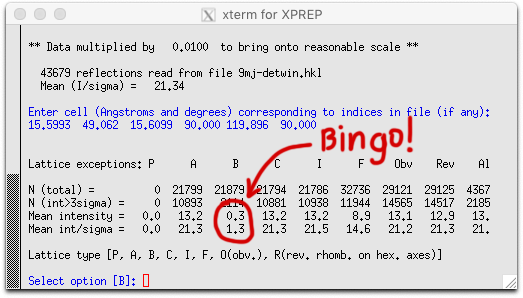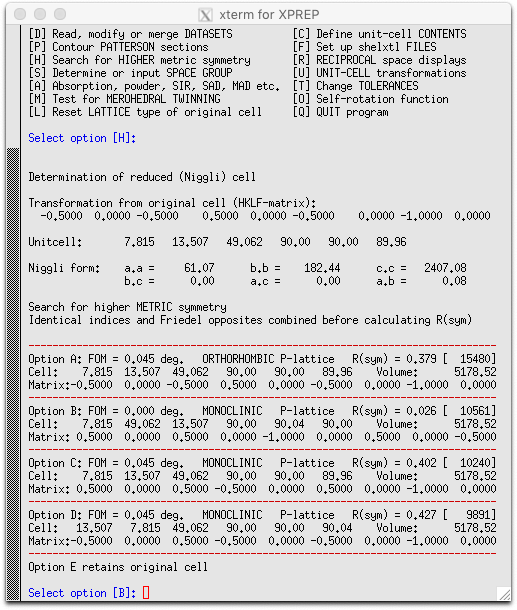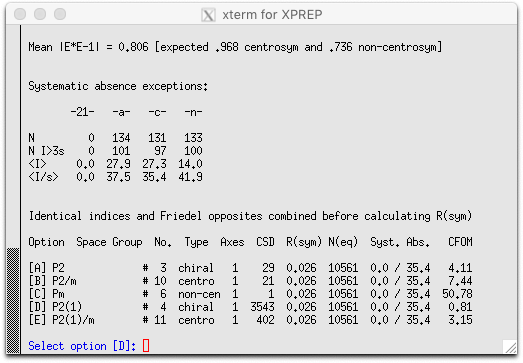
The important things to note here are the 'mean intensity' and 'int/sigma' in the 'B' column. The
numbers are tiny, which means that the unit cell with a ≈ c and
β ≈ 120° is B-centered, not primitive.
Although it would be trivial to pare down our P21 model for B21, we'll take the lazy route and re-solve the structure using a B-centered cell. We'll get to that in the last section. In the meantime, the B-centered cell must be equivalent to some primitive cell with half the volume. Before quitting XPREP, let's see what it suggests. A search for higher metric symmetry gives this:
Although it would be trivial to pare down our P21 model for B21, we'll take the lazy route and re-solve the structure using a B-centered cell. We'll get to that in the last section. In the meantime, the B-centered cell must be equivalent to some primitive cell with half the volume. Before quitting XPREP, let's see what it suggests. A search for higher metric symmetry gives this:

XPREP finds four clearly related cells. They all have the long ~49Å axis, one axis
that is half as long as the a and c of the pseudo-hexagonal cell, and
one axis that is √3/2 times as long. Option A (primitive orthorhombic)
can be rejected because it has lousy R(sym). It also finds three primitive monoclinic cells,
but only one (option B) has a good R(sym). The transformation matrix for option B is ...
... which gives β = 90.04°. To preserve the handedness, it rotates the cell so that b points in the opposite direction. Out of curiosity, let's see what XPREP suggests for the space group:
0.5
0
0.5
0
-1
0
0.5
0
-0.5
... which gives β = 90.04°. To preserve the handedness, it rotates the cell so that b points in the opposite direction. Out of curiosity, let's see what XPREP suggests for the space group:

Perhaps not surprisingly, it suggests P21. The obvious question then is, why
bother with an unconventional B-centered cell if the untwinned structure has a
smaller pseudo-orthorhombic primitive monoclinic cell ? The answer lies in the way that SHELXL
uses the TWIN instruction. In the B-centered setting, the same TWIN matrix can be applied
twice for the 2nd and 3rd components. Three-fold twinning for a pseudo-orthorhombic primitive
monoclinic model using SHELXL, however, would require 'HKLF 5' format data, which would
obscure the three-fold nature of the twinning, as we'll see in the next section.
1: Introduction
2: Set up instructions using XPREP
3: Solve using P21 with SHELXD
4: Detwin using SHELXL
5: Analyze detwinned dataset using XPREP
6: Three-fold twinning in graphic detail
7: Solve using B21 with SHELXD
2: Set up instructions using XPREP
3: Solve using P21 with SHELXD
4: Detwin using SHELXL
5: Analyze detwinned dataset using XPREP
6: Three-fold twinning in graphic detail
7: Solve using B21 with SHELXD